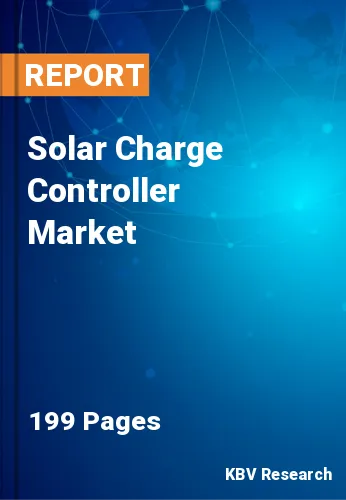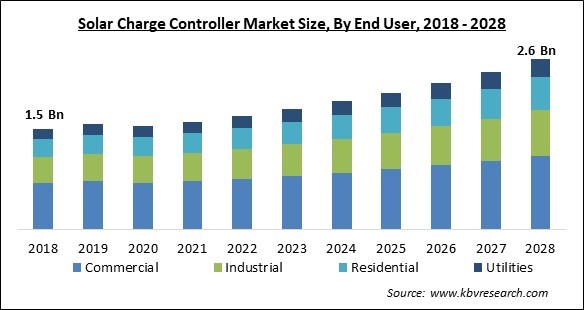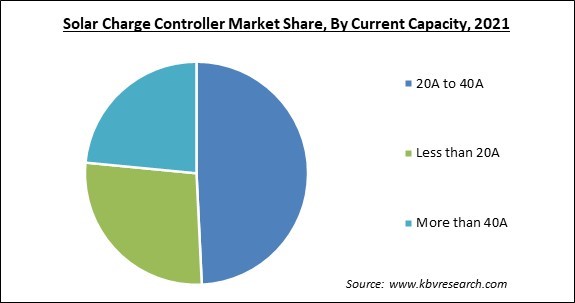
The Global Solar Charge Controller Market size is expected to reach $2.6 billion by 2028, rising at a market growth of 7.0 % CAGR during the forecast period.
Voltage is regulated & controlled by an electronic instrument, which is called a solar charge controller. In off-grid & hybrid off-grid applications, it is used to run electrical loads & charge batteries in order to produce the best output. Battery damage is prevented by solar charge controllers through preventing overcharging. Additionally, preserving battery health facilitates quick charging and lengthens battery life. The market for solar charge controllers has benefited from these product features.

The greatest alternative for electrical storage in the form of batteries is a solar charge controller, which is powered by solar energy. Since there is a lack of electricity in some areas of the world, there are frequent power outages in these areas. Furthermore, there has been a significant increase in demand for the installation of off-grid solar panel installations.
The solar charge controller regulates the voltage & current flow from the solar panels to the connected battery, guarding against overcharging or discharge of the battery. Off-grid solar panels typically use solar charge controllers to regulate the energy flow into batteries. The majority of commercially available solar charge controllers for PV systems regulate the charging current using a switched series regulator. A solar-powered voltage & current regulator is known as a solar charge controller. In off-grid and hybrid off-grid applications, they are used to regulate power input from PV arrays so that the best power output is delivered to run electrical loads & charge batteries. Solar charge regulators and solar charge converters are synonyms.
The COVID-19 outbreak affected almost all industries in one or another manner. The pandemic-related lockdown led to a temporary prohibition on production, processing, and import/export across numerous industries, which reduced demand for solar power components such as batteries, panels, controllers, & other parts. The development of the solar charge controller market was also affected by the suspension of solar energy power plant construction due to a lack of laborers and an expansion of the demand-supply imbalance during the pandemic period.
A significant trend in the solar industry is the spread of smart technology throughout numerous industrial spheres. The functional capabilities of solar charge controllers and, consequently, the output, are being greatly influenced by the integration of Bluetooth 4.0 as well as BLE (Bluetooth Smart) technologies. Bluetooth-enabled MPPT solar charge controllers are in use for parameter adjustment, wireless monitoring, and real-time data checking. The history of solar output, battery voltage, & overall load output are all included in the real-time data transfer.

Due to frequent power outages and the restricted electricity supply in some places, solar charge controller use is rising. This movement has been gaining ground in Latin American, African, and Asian countries. Recent growth in the installation of off-grid solar panel systems is an important development in the solar charge controller market. Growing awareness and financial incentives for the installation of solar panel systems based off the grid will have a substantial positive impact on the market for solar charge controllers.
Solar energy is expensive, at least initially. Depending on the components companies select, the cost to install a system to power the typical American home could range from $8,000 to $10,000. The price of delivery and installation is not included. Even while someone starts to break even on the investment over time and start to make money, not everyone has thousands of dollars lying around to invest in their solar aspirations. The primary obstacle to going solar is the initial cost. There are financing alternatives available, and even when interest is considered in, the payback period is extremely favorable. But not everybody wants to be responsible for making loan payments.
Based on type, the solar charge controller market is fragmented into Pulse Width Modulation (PWM), Maximum Power Point Tracking (MPPT), and Simple 1 or 2 stage Control. This is linked to an increase in the worldwide deployment of solar power generation infrastructure. Additionally, MPPT solar charge controllers extract the most electricity possible from solar panels and perform better than PWM solar charge controllers in terms of efficiency & performance, all of which are anticipated to propel the market's expansion over the forecast period.
By current capacity, the solar charge controller market is segmented into Less than 20A, 20A to 40A, and more than 40A. The more than 40A segment procured a substantial revenue share in the solar charge controller market in 2021. The solar charge controllers with more than 40A capacity are considered to be the most efficient. Such solar charge controllers provide maximum power point solar charging with up to 99 percent tracking efficiency, supplying additional energy to the battery bank due to which the demand for these solar charge controllers is increasing.
Based on the end-user, the solar charge controller market is classified into residential, industrial commercial and utilities. The industrial segment covered a substantial revenue share in the solar charge controller market in 2021. For large-scale solar installations, MPPT solar charge controllers without load output terminals were designed. In utility-scale solar arrays, the controllers are integrated with sizable off-grid inverters. Over the projected period, the segment's expansion is expected to be fueled by increased industrial-scale project activity and rising clean electricity demand.
| Report Attribute | Details |
|---|---|
| Market size value in 2021 | USD 1.6 Billion |
| Market size forecast in 2028 | USD 2.6 Billion |
| Base Year | 2021 |
| Historical Period | 2018 to 2020 |
| Forecast Period | 2022 to 2028 |
| Revenue Growth Rate | CAGR of 7% from 2022 to 2028 |
| Number of Pages | 199 |
| Number of Tables | 360 |
| Report coverage | Market Trends, Revenue Estimation and Forecast, Segmentation Analysis, Regional and Country Breakdown, Companies Strategic Developments, Company Profiling |
| Segments covered | Type, Current Capacity, End User, Region |
| Country scope | US, Canada, Mexico, Germany, UK, France, Russia, Spain, Italy, China, Japan, India, South Korea, Singapore, Malaysia, Brazil, Argentina, UAE, Saudi Arabia, South Africa, Nigeria |
| Growth Drivers |
|
| Restraints |
|
Region-wise, the solar charge controller market is analyzed across North America, Europe, Asia Pacific, and LAMEA. Asia Pacific acquired the highest revenue share in the solar charge controller market in 2021. The Asia Pacific region's substantial customer base and important player presence are the major factors responsible for the growth of the regional solar charge controller market. China provides the largest portion of revenue. In addition to the rise of commercial offices, the growing electricity demand-supply mismatch in developing economies is predicted to accelerate regional market growth during the projection period.
Free Valuable Insights: Global Solar Charge Controller Market size to reach USD 2.6 Billion by 2028
The market research report covers the analysis of key stake holders of the market. Key companies profiled in the report include Schneider Electric SE, EnerSys, Xantrex Technologies, Inc. (Mission Critical Electronics LLC), Sunforge LLC, Luminous Power Technologies (P) Ltd., Studer Innotec SA, KATEK Memmingen GmbH, Shenzhen Shuori New Energy Technology Co. Ltd., Microtek International Pvt Ltd., and Phocas AG.
By End User
By Type
By Current Capacity
By Geography
The global Solar Charge Controller Market size is expected to reach $2.6 billion by 2028.
The Use Of Smart Communication Technology Accelerates The Demand are driving the market in coming years, however, Expensive Installation As Well As Energy Storage restraints the growth of the market.
Schneider Electric SE, EnerSys, Xantrex Technologies, Inc. (Mission Critical Electronics LLC), Sunforge LLC, Luminous Power Technologies (P) Ltd., Studer Innotec SA, KATEK Memmingen GmbH, Shenzhen Shuori New Energy Technology Co. Ltd., Microtek International Pvt Ltd., and Phocas AG.
The Commercial segment acquired maximum revenue share in the Global Solar Charge Controller Market by End User in 2021 thereby, achieving a market value of $1.1 billion by 2028.
The 20A to 40A segment is leading the Global Solar Charge Controller Market by Current Capacity in 2021 thereby, achieving a market value of $1.2 billion by 2028.
The Asia Pacific market dominated the Global Solar Charge Controller Market by Region in 2021, and would continue to be a dominant market till 2028; thereby, achieving a market value of $1,018.4 million by 2028.
Our team of dedicated experts can provide you with attractive expansion opportunities for your business.
